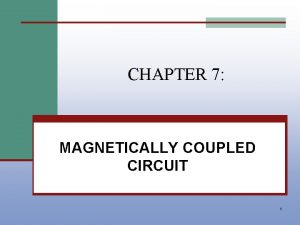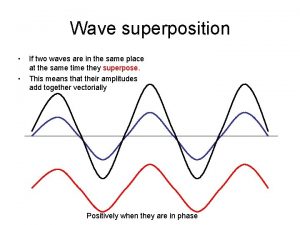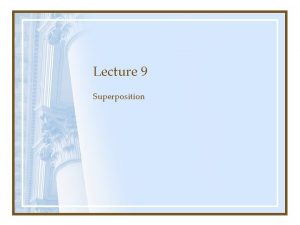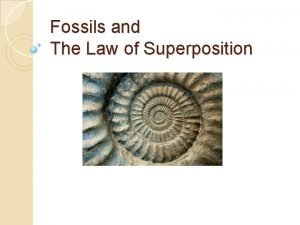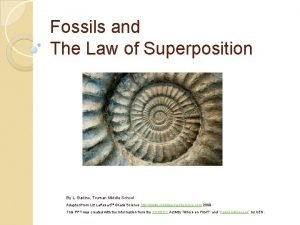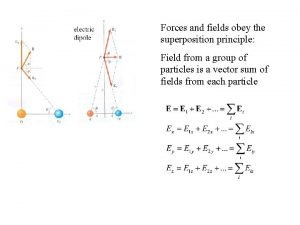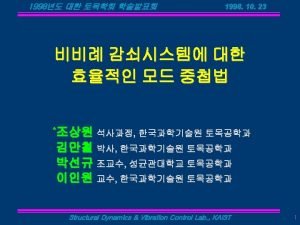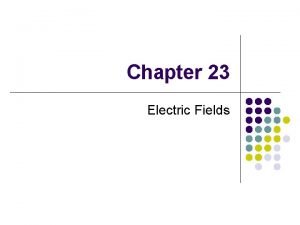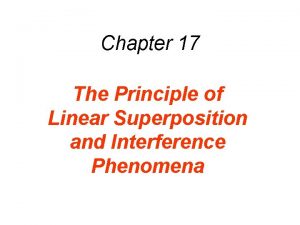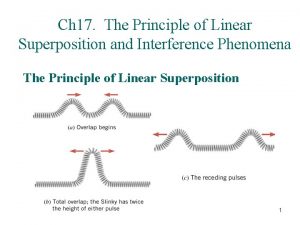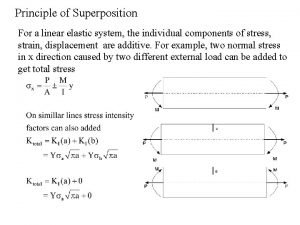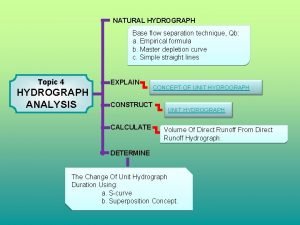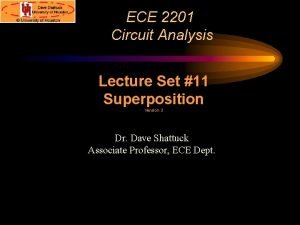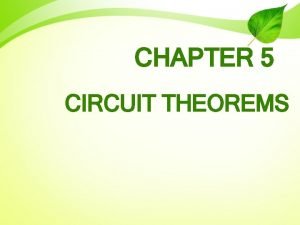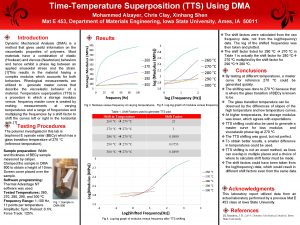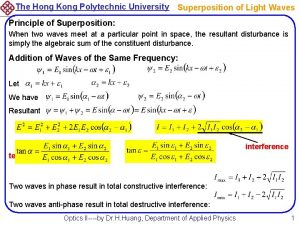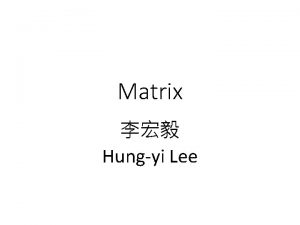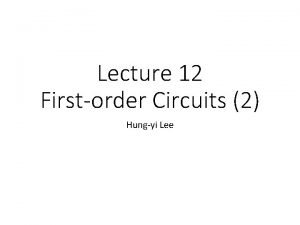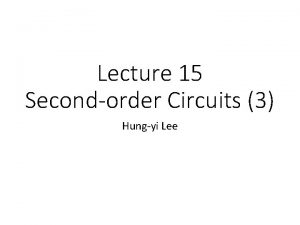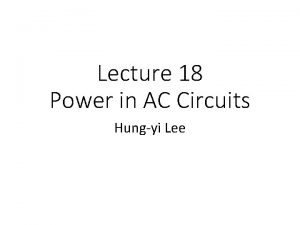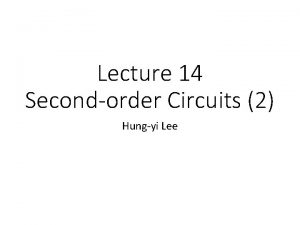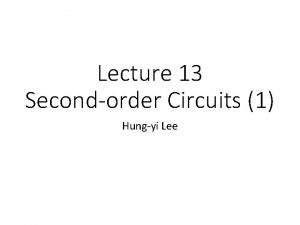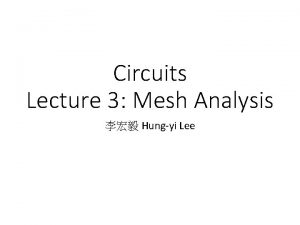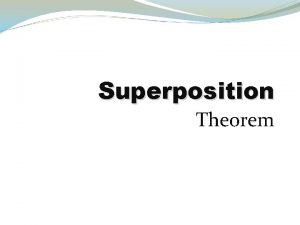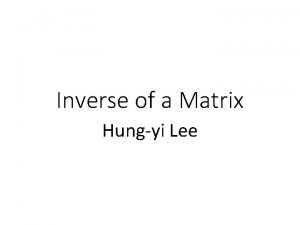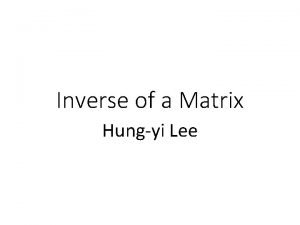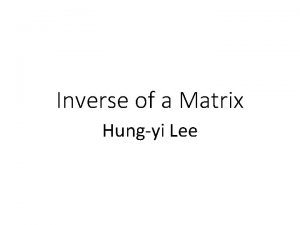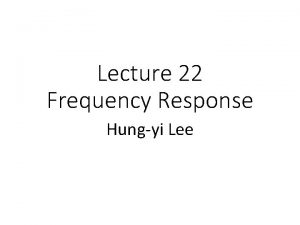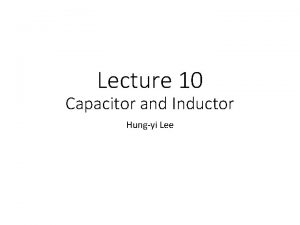Circuits Lecture 4 Superposition Hungyi Lee Outline Matrix































- Slides: 31

Circuits Lecture 4: Superposition 李宏毅 Hung-yi Lee

Outline • Matrix Equation for Node and Mesh analysis • Chapter 4. 1, 4. 2 • Superposition • Chapter 2. 4

Node Analysis v 1: v 2: v 3:

Node Analysis Resistance Node Sources potentials You can directly write the matrix equation below. (textbook, P 139)

Node Analysis v 1, v 2, v 3 is the weighted sum of is and vs ØNode potential is the weighted sum of the values of sources ØVoltage (potential difference) is the weighted sum of the values of sources

Mesh Analysis For mesh 1 Ra(i 1 -is)+Rbi 1+Rc(i 1 -i 2)-vs=0 For mesh 2 Rc(i 2 -i 1)+Rdi 2+Re(i 2 -i 3)=0 For mesh 3 Re(i 3 -i 2)+Rfi 3+vs=0 You can directly write the (textbook, P 153) matrix equation below.

Mesh Analysis Resistance Mesh Current Sources

Mesh Analysis i 1, i 2, i 3 is the weighted sum of is and vs ØMesh currents are the weighted sum of the values of sources ØCurrents of the braches are the weighted sum of the values of sources

Linearity Based on node and mesh analysis: • y: any current or voltage for an element • xi: current of current sources or voltage of voltage sources Any current (or voltage) for an element is the weighted sum of the voltage (or current) of the sources.

Linearity - Example Any current (or voltage) for an element is the weighted sum of the voltage (or current) of the sources.

Not apply on Power • xi: current of independent current sources or voltage of independent voltage sources Voltage: Power: Current :

Proportionality Principle – One Independent Sources Complex Circuit Find i 1 and v 1 when vs is 9 V, 72 V and 0. 9 V

Superposition Principle – Multiple Independent Sources • Example 2. 10 • Find i 1 We can find i 1 -1, i 1 -2, i 1 -3 separately. When x 2=0 and x 3=0, The current through 2Ω is i 1 -1.

Superposition Principle – Multiple Independent Sources • Example 2. 10 • Find i 1 We can find i 1 -1, i 1 -2, i 1 -3 separately. Current of current source set to be zero. Open Circuit

Superposition Principle – Multiple Independent Sources • Example 2. 10 • Find i 1 We can find i 1 -1, i 1 -2, i 1 -3 separately. To find i 1 -2, we set x 1=0 and x 3=0. Now the current through 2Ω is i 1 -2.

Superposition Principle – Multiple Independent Sources • Example 2. 10 • Find i 1 We can find i 1 -1, i 1 -2, i 1 -3 separately. Voltage of voltage source set to be zero. Short Circuit

Superposition Principle – Multiple Independent Sources • Example 2. 10 • Find i 1 We can find i 1 -1, i 1 -2, i 1 -3 separately.

Superposition Principle – Multiple Independent Sources • Example 2. 10 • Find i 1 We can find i 1 -1, i 1 -2, i 1 -3 separately. set x 2=0 and x 3=0 set x 1=0 and x 2=0

Superposition Principle – Multiple Independent Sources • Steps to apply Superposition Principle: • If the circuit has multiple sources, to find a voltage or current for an element • For each source • Keep the source unchanged • All the other sources set to zero • Voltage source’s voltage set to 0 = Short circuit • Current source’s current set to 0 = open circuit • Find the voltage or current for the element • Add all the voltages or currents obtain by individual sources

Remind • Always using superposition when there are multiple sources? Three circuits (1 source) One circuit (3 sources) v. s.

Concluding Remarks This equation only for circuits with sources and resistors. • • y: any current or voltage for an element xi: current of current sources or voltage of voltage sources Proportionality Principle, Superposition Principle Can be used in any circuit in this course

Linearity • A circuit is a multiple-input multiple-output (MIMO) system • Input: current of current sources or voltage of voltage sources • Output: the current or voltage for the elements input Circuit (System) + - output

Linearity All circuits in this courses are linear circuits. • All linear circuits are linear system • Linear Circuit: All circuits in this • Sources courses are • Linear Elements: linear systems. • Resistor, Capacitor, Inductor

Linearity • Linear System: • Property 1: Input: g 1(t), g 2(t), g 3(t), …… output: h 1(t), h 2(t), h 3(t), …… Input: Kg 1(t), Kg 2(t), Kg 3(t), …… output: Kh 1(t), Kh 2(t), Kh 3(t), …… Proportionality Principle

Linearity • Linear System: • Property 2: Input: a 1(t), a 2(t), a 3(t), …… output: x 1(t), x 2(t), x 3(t), …… Input: b 1(t), b 2(t), b 3(t), …… output: y 1(t), y 2(t), y 3(t), …… Input: a 1(t)+ b 1(t), a 2(t)+ b 2(t), a 3(t)+ b 3(t), …… output: x 1(t)+y 1(t), x 2(t)+y 2(t), x 3(t)+y 3(t), …… Superposition Principle

Linearity • Linear System: • Property 2: Input: a 1(t), a 2(t), a 3(t), …… output: x 1(t), x 2(t), x 3(t), …… Input: b 1(t), b 2(t), b 3(t), …… output: y 1(t), y 2(t), y 3(t), …… Input: a 1(t)+ b 1(t), a 2(t)+ b 2(t), a 3(t)+ b 3(t), …… output: x 1(t)+y 1(t), x 2(t)+y 2(t), x 3(t)+y 3(t), …… Superposition Principle

Linearity Superposition Principle can be applied on any circuit in this course (Textbook: Chapter 6. 5).

Homework • 2. 50 Given vs and R 3, find vb

Homework • 2. 52 Given is, find vs such that v 4= 36 V

Thank you!

Answer • 2. 50 • -12 V • 2. 52 • 60 V
 Hungyi lee
Hungyi lee Hungyi lee
Hungyi lee Hungyi lee
Hungyi lee Hungyi lee
Hungyi lee Hungyi
Hungyi Elec 202
Elec 202 What is a parallel circuit in physics
What is a parallel circuit in physics Magnetically coupled circuits lecture notes
Magnetically coupled circuits lecture notes 01:640:244 lecture notes - lecture 15: plat, idah, farad
01:640:244 lecture notes - lecture 15: plat, idah, farad Lesson outline lesson 3 describing circuits answers
Lesson outline lesson 3 describing circuits answers Lecture outline example
Lecture outline example Lecture outline example
Lecture outline example Lecture outline example
Lecture outline example Lecture outline meaning
Lecture outline meaning Stiffness matrix method lecture notes
Stiffness matrix method lecture notes Quote sandwich
Quote sandwich Law of superposition examples
Law of superposition examples Superposition
Superposition Superposition theorem examples
Superposition theorem examples Superposition fossils
Superposition fossils Superposition in fossils
Superposition in fossils Superposition principle
Superposition principle Mode superposition method structural dynamics
Mode superposition method structural dynamics Superposition principle for electric field
Superposition principle for electric field Linear superposition
Linear superposition The principle of linear superposition
The principle of linear superposition Principle of superposition in stress and strain
Principle of superposition in stress and strain Unit hydrograph superposition method
Unit hydrograph superposition method Superposition ece
Superposition ece Source transformation circuits
Source transformation circuits Time temperature superposition dma
Time temperature superposition dma Superposition of light
Superposition of light







